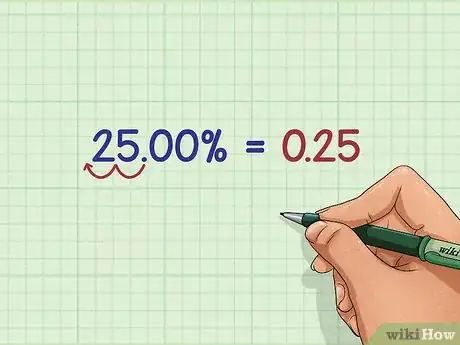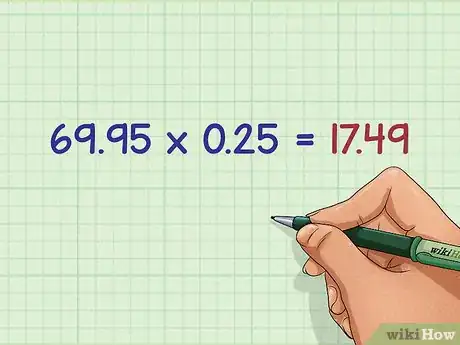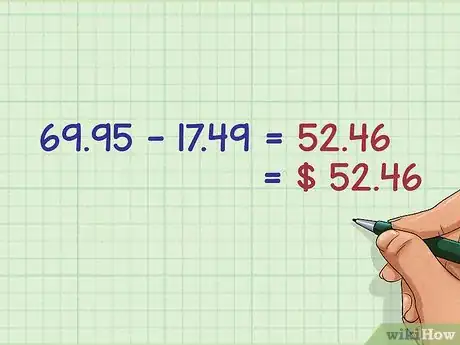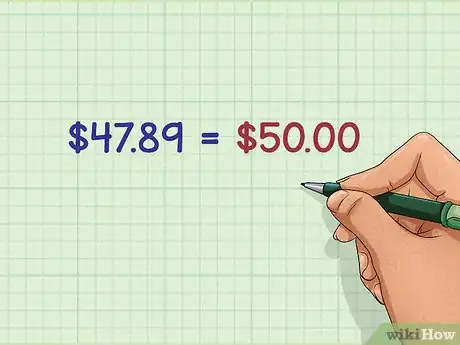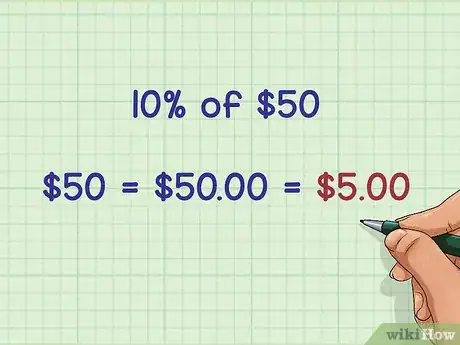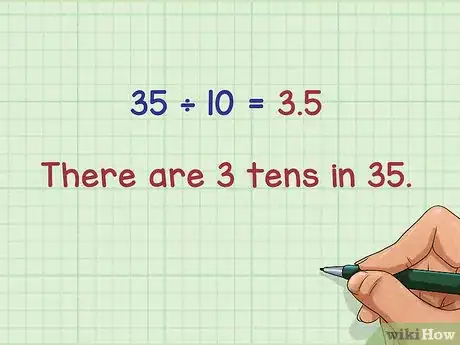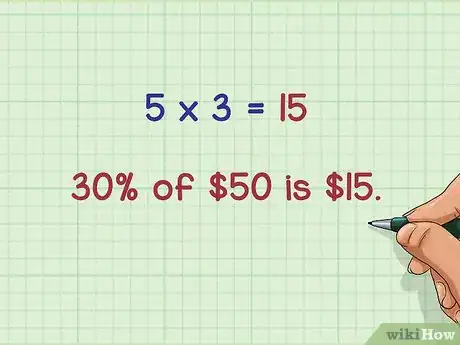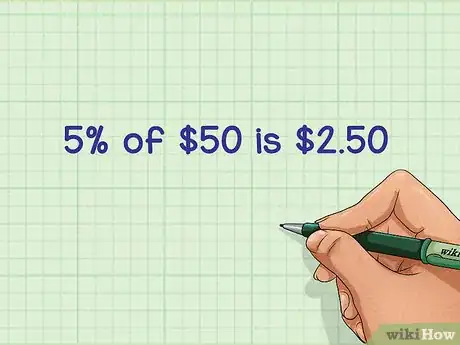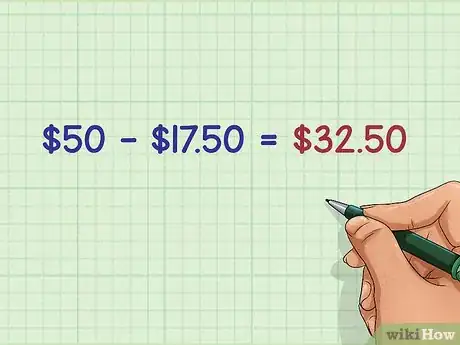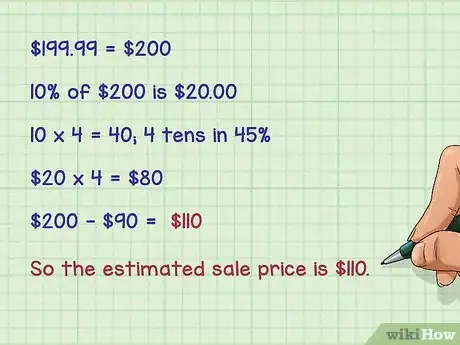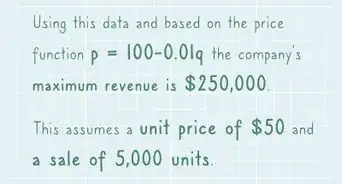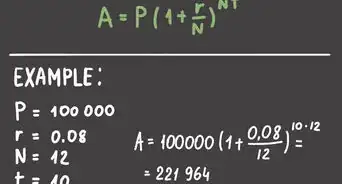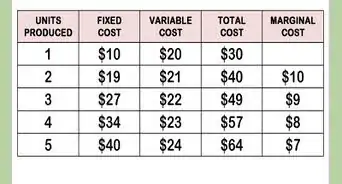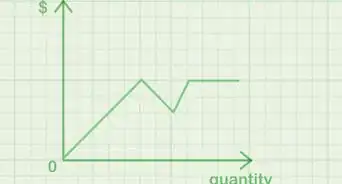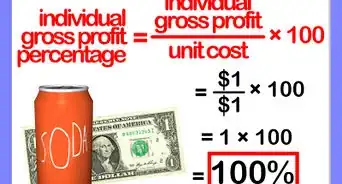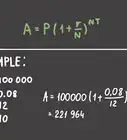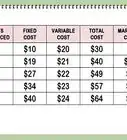This article was co-authored by wikiHow Staff. Our trained team of editors and researchers validate articles for accuracy and comprehensiveness. wikiHow's Content Management Team carefully monitors the work from our editorial staff to ensure that each article is backed by trusted research and meets our high quality standards.
This article has been viewed 1,293,667 times.
Learn more...
Calculating a discount is one of the most useful math skills you can learn. You can apply it to tips at a restaurant, sales in stores, and setting rates for your own services. The basic way to calculate a discount is to multiply the original price by the decimal form of the percentage. To calculate the sale price of an item, subtract the discount from the original price. You can do this using a calculator, or you can round the price and estimate the discount in your head.
Steps
Calculating the Discount and Sale Price
-
1Convert the percentage discount to a decimal. To do this, think of the percent number with a decimal to the right of the last digit. Move the decimal point two places to the left to get the converted decimal.[1] You can also use the sign on a calculator.
- For example, you might want to calculate the sale price of a pair of shoes that is regularly $69.95. If the shoes are 25% off, you need to convert 25% to a decimal by thinking .
-
2Multiply the original price by the decimal. You can multiply the decimal by hand, or use a calculator. This will tell you the discount, or what value is being taken off the original price.[2]
- For example, to find the 25% discount on a pair of $69.95 shoes, you would calculate .
Advertisement -
3Subtract the discount from the original price. To subtract decimals, line up the decimal points and subtract as you would whole numbers. Be careful to drop the decimal point down into your answer. You can also use a calculator. The difference will be the sale price of the item.[3]
- For example, if a pair of shoes that are originally $69.95 have a discount of $17.49, calculate the sale price by subtracting:. So, the shoes are on sale for $52.46.
Estimating the Discount and Sale Price
-
1Round the original price to the nearest ten. Use normal rounding rules to round up or down. Doing this will make it easier to calculate the percent discount of the number.
- For example, if the original price of a shirt is $47.89, round the price up to $50.00
-
2Calculate 10 percent of the rounded price. To mentally calculate 10% of a price, think of the price written as dollars and cents with a decimal point. Then, move the decimal point one place to the left. This will show you the number that is equal to 10%.[4]
- For example, to calculate 10% of $50, think . So, 5 is 10% of 50.
-
3Determine the number of tens in the percent off. To figure out the number of tens, divide by the percentage by 10 using normal division rules. Don’t worry about fives in the percentage for now.
- For example, if a shirt is 35% off, you would need to know how many tens are in 35. Since , there are 3 tens in 35.
-
4Multiply 10% of the rounded price by the appropriate factor. The factor is determined by the number of tens in the percent off. Since you determined what 10% of the price is, find a larger percent by multiplying by the number of tens.
- For example, if you found that 10% of $50 is 5, to find out how much 30% of 50 is, you would multiply $5 by 3, since there are 3 tens in 30: . So, 30% of $50 is $15.
-
5Calculate 5% of the rounded price, if necessary. You will need to do this step if the percent off discount ends in a 5 rather than a 0 (for example, 35% or 55% off). It is easy to calculate 5% by simply dividing 10% of the original price by 2, since 5% is half of 10%.
- For example, if 10% of $50 is $5, then 5% of $50 is $2.50, since $2.50 is half of $5.
-
6Add the remaining 5% to the discount, if necessary. This will give you the total estimated discount of the item.
- For example, if a shirt is 35% off, you first found 30% of the original price was $15. Then you found that 5% of the original price was $2.50. So adding the values of 30% and 5%, you get . So, the estimated discount of the shirt is $17.50.
-
7Subtract the discount from the rounded price. This will give you an estimate of the sale price of the item.
- For example, if the rounded price of a shirt is $50, and you found the 35% discount to be $17.50, you would calculate . So, a $47.89 shirt that is 35% off is about $32.50 on sale.
Completing Sample Problems
-
1Calculate the exact sale price. A television is originally priced at $154.88. It now has a 40% discount.
- Convert the percentage discount to a decimal by moving the decimal two places to the left: .
- Multiply the original price by the decimal: .
- Subtract the discount from the original price: . So, the sale price of the television is $92.93.
-
2Find the exact sale price of a camera that is 15% off. The original price is $449.95.
- Convert the percentage discount to a decimal by moving the decimal two places to the left: .
- Multiply the original price by the decimal: .
- Subtract the discount from the original price: . So, the sale price of the camera is $382.46.
-
3Estimate the sale price. A tablet is regularly $199.99. On sale, it is 45% off.
- Round the original price to the nearest ten. Since $199.99 is only 1 cent away from $200, you would round up.
- Calculate 10% of the rounded price. Moving the decimal one place to the left, you should see that 10% of $200.00 is $20.00.
- Determine the number of tens in the percent off. Since , you know that there are 4 tens in 45%.
- Multiply 10% of the rounded price by the appropriate factor. Since the percentage off is 45%, you would multiply 10% of the rounded price by 4:
- Calculate 5% of the rounded price. This is half of 10%, which is $20. So half of $20 is $10.
- Add the remaining 5% to the discount. 40% is $80, and 5% is $10, so 45% is $90.
- Subtract the discount from the rounded price: . So the estimated sale price is $110.
Community Q&A
-
QuestionHow do I calculate a discount if the rate is unknown?
 Judy McGuirkCommunity AnswerAssuming you know the original price and the sale price of an item, subtract sale price from original price to determine the discount amount. Next, divide the discount amount by original price. Convert this decimal amount into a percentage. This percent is the discount rate. For an example, a lamp shows a discount price of $30 with an original price of $50. $50 - $30 = $20 20 / 50 = 0.40 0.40 = 40%
Judy McGuirkCommunity AnswerAssuming you know the original price and the sale price of an item, subtract sale price from original price to determine the discount amount. Next, divide the discount amount by original price. Convert this decimal amount into a percentage. This percent is the discount rate. For an example, a lamp shows a discount price of $30 with an original price of $50. $50 - $30 = $20 20 / 50 = 0.40 0.40 = 40% -
QuestionA product that regularly sells for $425 is marked down to $318.75. What is the discount rate?
 Lorejane CastilloCommunity AnswerIf the product regular price is $425 and the discounted price is $318.75. Divide the disc. price to orig. price EX. 318.75 / 425= 0.75, then multiply the 0.75 into 100 and 100 is the total % of an item Ex. 0.75x100= 75, now subtract the 100 to 75 . Ex. 100- 75= 25%. So the discount rate is = 25%.
Lorejane CastilloCommunity AnswerIf the product regular price is $425 and the discounted price is $318.75. Divide the disc. price to orig. price EX. 318.75 / 425= 0.75, then multiply the 0.75 into 100 and 100 is the total % of an item Ex. 0.75x100= 75, now subtract the 100 to 75 . Ex. 100- 75= 25%. So the discount rate is = 25%. -
QuestionCan I convert the decimal to a fraction, then multiply by the original price?
 Community AnswerYes, as long as your conversion is right.
Community AnswerYes, as long as your conversion is right.
References
- ↑ http://www.mathsisfun.com/converting-percents-decimals.html
- ↑ http://www.mathgoodies.com/lessons/percent/sale_price.html
- ↑ http://www.purplemath.com/modules/percntof2.htm
- ↑ http://www.homeschoolmath.net/teaching/percent/percent_of_number_mental_math.php
- ↑ http://www.dummies.com/how-to/content/how-to-calculate-a-percentage-discount.html
About This Article
To calculate a discount, start by converting the discount percentage to a decimal. Think of the percent number with a decimal to the right of the last digit, then move the decimal point two places to the left to convert it. Next, multiply the original price by the decimal either by hand or by using a calculator. This gives you the discount amount, or what value is being taken off the original price. Then, subtract the discount amount from the original price to figure out the discounted price. If you want to learn how to quickly estimate the discounted price for an item, keep reading the article!
